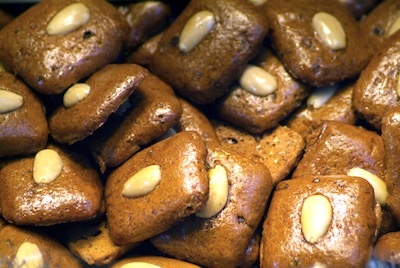Shore Excursion: Necessity was the mother of printen cookies
Aachen, Germany – On a beautiful Sunday afternoon, folks are strolling around the historic Aachen square in Germany. Church bells are chiming in the distance. A small band is playing a lively tune, prompting a young couple to do a quick dance before heading into a nearby coffee shop.
A youngster is happily munching away on a spicy cookie known as “printen,” a traditional sweet for which Aachen has been famed for generations.
That’s what I want to do – savor one of those delicious sweets. And it certainly isn’t difficult to find one of those special printen shops. Just follow my nose.
The shops are everywhere on the winding streets of Aachen. A woman is passing out free samples in an open shop window. She offers several different types. A few stores down another woman is giving samples over a big display case while customers mull over the tempting choices.
“We are the sweet capital of Germany because of our gingerbread and our chocolates,” says Werner Schlösser, tourism manager for Aachen. “That is something that we are famous for. It is an important part of our history.”
LONG HISTORY FOR PRINTEN COOKIES
The name “printe” is derived from the English term “to print.” In earlier times pressure molds that were cut into wood were used for the printen manufacturing. Those molds gave the printen their characteristic shapes.
The baking recipe is still guarded by Aachen printen bakers as a “family secret.” Printen come in many variations – hard and soft, with herbs, chocolate or nuts and in all kinds of shapes. It is made with a delicious mix of cinnamon, aniseed, clove, cardamom, coriander, allspice and ginger (the proportions are secret).
When I first heard them called gingerbread, I thought they would be like the cake my grandmother used to make. They are not. Printen are much firmer, great to dunk in coffee.
Printen have an interesting history behind them, a salute to the creativity of the people of Aachen. It started when Napoleon appeared on the world’s stage and brought the Continental System. This meant that printen bakers were cut off from their supplies of raw sugar and American wild flower honey.
Determined not to do without their beloved printen, Aachen bakers were forced to improvise. They used substitutes like beet sugar and syrup. The result, of course, was a much coarser and thicker dough that was harder to shape. That is how the flat and slender “cut printe” was born.
Legend says that master baker Henry Lambertz created the sugar solution. The new design also was easier to manufacture and to distribute. If you would like to try making the printen yourself, here is a recipe:
Aachen Printen
1/3 cups molasses
water
½ cup sugar
1 tsp. baking soda
¼ cups all- purpose flour
½ cup finely chopped candied lemons peel
½ tsp. ground cinnamon
¼ tsp. ground cloves
¼ tsp. ground coriander
¼ tsp. ground nutmeg
¼ tsp. ground cardamom
Preheat oven to 400F (205 C). In a small saucepan, combine molasses and water. Heat over medium heat, stirring constantly, until blended; cool slightly. Stir sugar into cooled molasses mixture. In a large bowl, combine baking soda, flour, lemon peel, cinnamon, cloves, coriander, nutmeg and cardamom. Gradually stir molasses mixture into flour mixture. Blend quickly and thoroughly until smooth. Divide dough in to thirds. On a lightly floured surface, roll out dough into a thin sheet. Cut into 3” x 1” rectangles using a ruler and pastry wheel. Rinse a baking sheet in cold water. Do not dry. Place cut out cookies on damp baking sheet. Bake 8 to 10 minutes. Remove cookies from baking sheets; place on cooling racks. When cooled, store in a tightly sealed container. Makes about 100 cookies.
Photo by Jackie Sheckler Finch















View Recent Comments